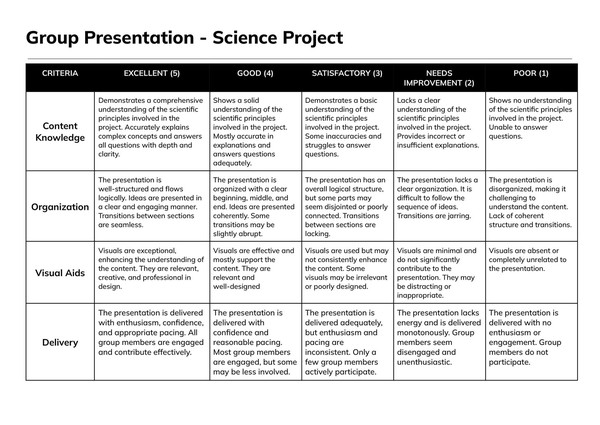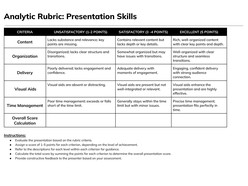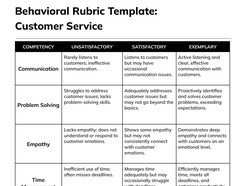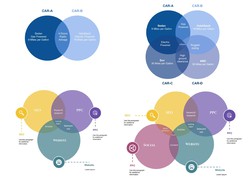A practical, easy-to-use group project rubric template designed in Google Docs. This template allows educators to assess multiple facets of group work, from collaboration and communication to individual contributions and the final project quality.
Content & Design Details:
Clear, editable rubric format with rows for assessment criteria and columns for performance levels.
Predefined performance levels (e.g., Excellent, Good, Needs Improvement).
Customizable criteria that can be tailored to specific projects or group tasks.
Structured for both formative and summative assessment needs.
Facilitates transparent grading by breaking down group project components.
Ideal for K–12 educators, higher education instructors, and project-based learning environments.
This template is perfect for any collaborative group assignment, from research projects to presentations and case studies.
Format: Google Docs
Contributed by: Olivia Davis
How to Use
Accessing and editing the template in Google Docs takes only a few steps:
- Click the Download Template button to open the document in Google Docs.
- Select the Use Template button located in the top-right corner of the page.
- Ensure you are signed into your Google account to save and begin editing the file.
Once saved, the template becomes fully editable — ready for customization, printing, and sharing.
How to Assess Group Projects Using a Rubric in Google Docs
Group projects often present unique grading challenges. Using a rubric allows instructors to objectively evaluate both the process and product of group work, ensuring all students receive fair, transparent feedback.
1. Define Clear Evaluation Criteria
For group projects, it’s essential to assess both teamwork and the final product. Typical criteria might include:
Collaboration & Teamwork
Communication
Individual Contribution
Project Quality (e.g., Research, Presentation, Creativity)
Define these clearly to ensure that students understand what aspects of their work will be evaluated.
2. Set Performance Levels for Each Criterion
Performance levels should indicate how well students meet each criterion. For example:
Excellent Collaboration: “Actively contributes ideas, listens to others, and works seamlessly within the team.”
Needs Improvement Communication: “Rarely communicates with team members and provides unclear contributions.”
Using Google Docs, these levels can be customized to fit specific project requirements, ensuring fair and consistent grading.
3. Format the Rubric in Google Docs for Easy Customization
The Google Docs table feature makes it easy to build rubrics. Create rows for each criterion and columns for performance levels. Adjust the table as necessary to fit the assignment. This format ensures a professional and uniform approach to evaluation.
4. Use the Rubric for Both Peer and Teacher Assessment
Group project rubrics can be used not only for teacher grading but also for peer assessment. Students can evaluate each other’s contributions, providing valuable feedback and fostering accountability within the group.
5. Provide Constructive Feedback
Use the comment sections in the rubric to give specific, actionable feedback. Highlight strengths and areas for improvement, whether it’s in team communication, research depth, or presentation skills. Google Docs’ comment feature allows for quick, collaborative feedback exchanges.
Why Google Docs Is Ideal for Group Project Rubrics
Using a group project rubric in Google Docs not only ensures fair grading but also supports a clear and efficient process for evaluating collaboration and contributions. Whether you’re assessing a research paper, a group presentation, or a creative project, this template provides an adaptable and streamlined solution for educators.










